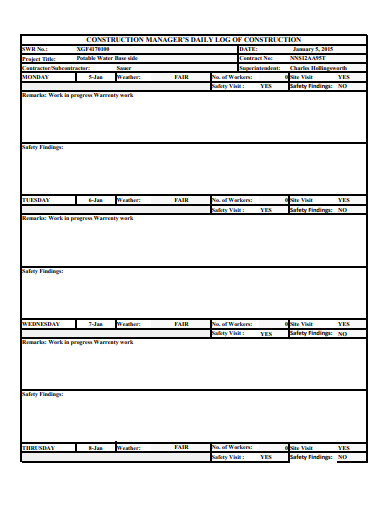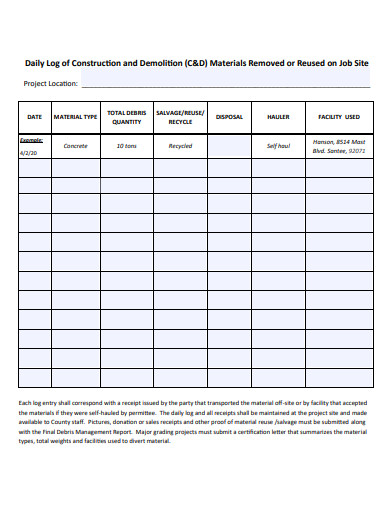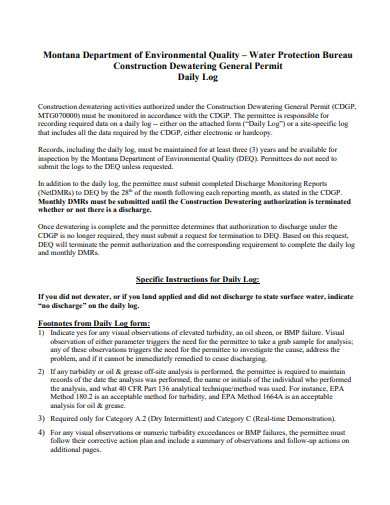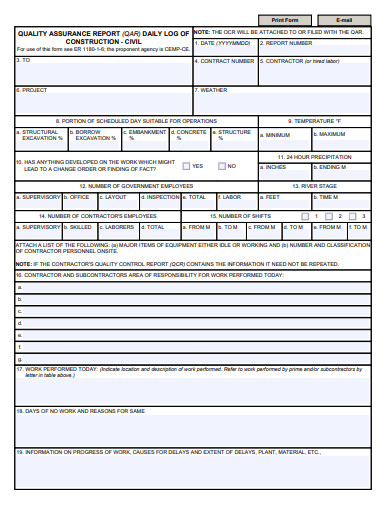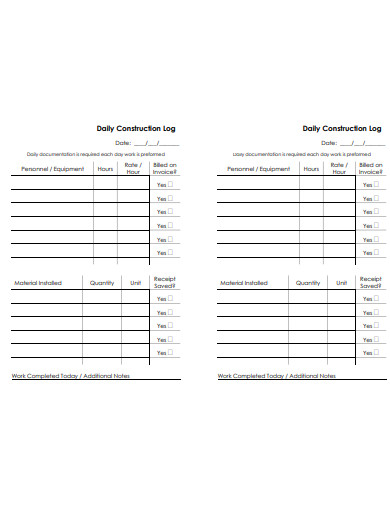Keeping track of daily construction activities is essential for ensuring project success and addressing potential issues promptly. The Construction Daily Log Sample provides a comprehensive template designed to capture every vital detail, from workforce attendance to equipment usage, weather conditions to task progress. Adopting such a systematic approach not only ensures transparency and accountability but also aids in efficient project management. By documenting daily happenings, construction teams can ensure that every aspect of the project runs smoothly and that all stakeholders remain informed.
1. Log Template Bundle
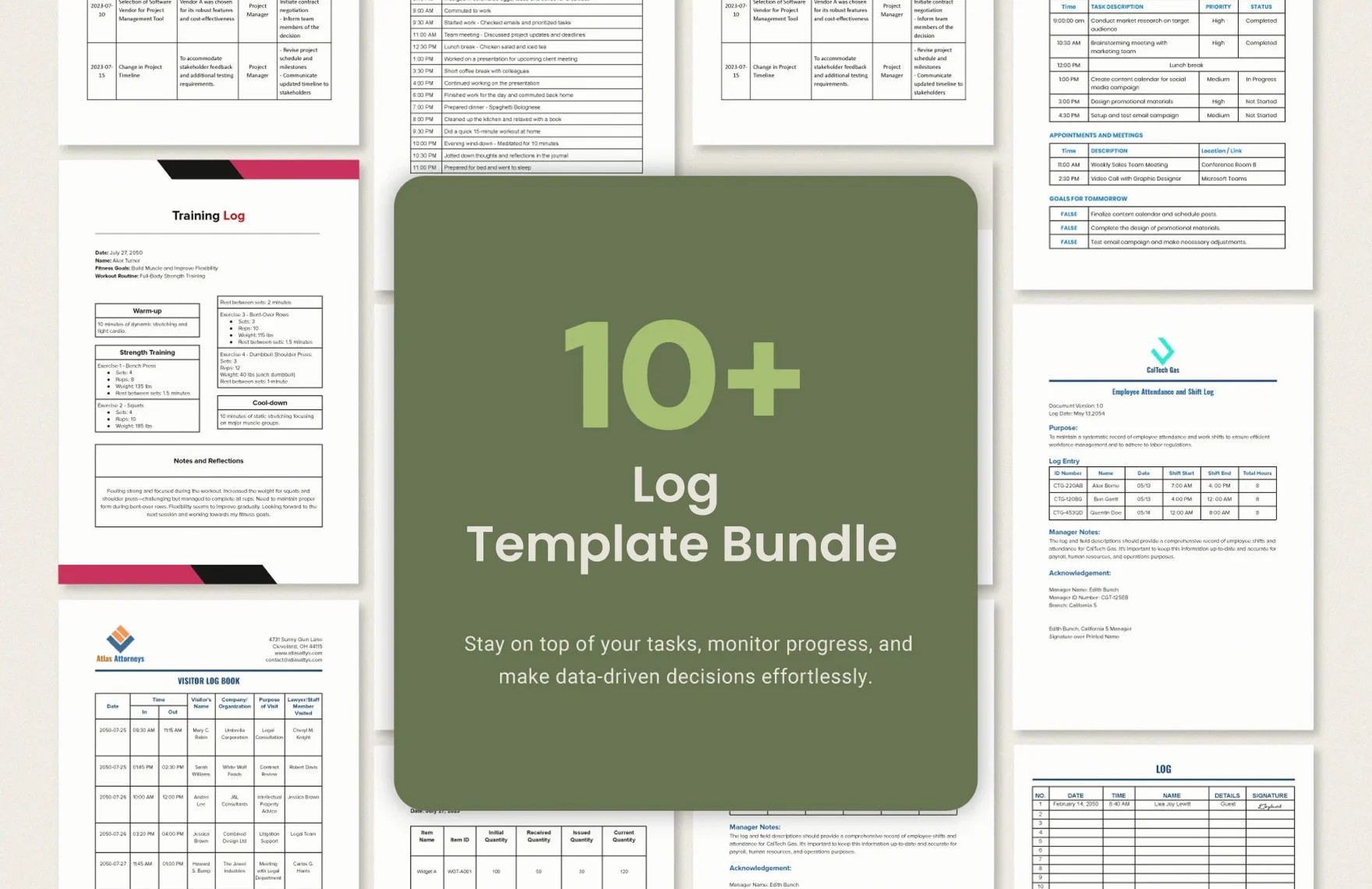
2. Construction Daily Log Template
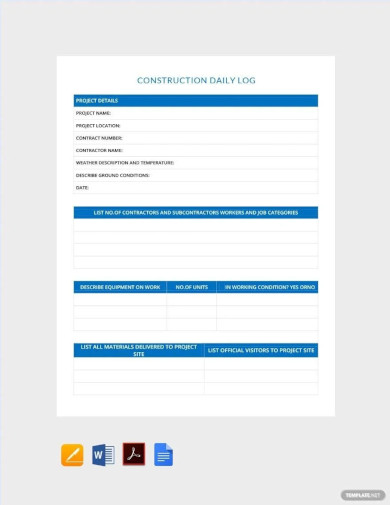
3. Construction Managers Daily Log Template
4. Construction Operations Daily Log Template
5. Basic Construction Daily Log Template
6. Construction Daily Log in PDF
7. Printable Construction Daily Log Template
8. Simple Construction Daily Log Template
What Is a Construction Daily Log?
A Construction Daily Log, as its name suggests, is a record that documents the daily activities, tasks, and events of a construction project. It serves as an official account of everything that happens on the construction site each day. This isn’t just a regular diary; it’s a strategic tool. Whether it’s noting the work completed by a contractor, tracking employee attendance, or listing equipment used, the Construction Log ensures that every detail is captured. Moreover, it often takes the form of a spreadsheet or a logbook, simplifying the process of recording and accessing information.
Utilizing a Construction Daily Report enhances transparency, efficiency, and accountability in the project. It also serves as an essential construction checklist, ensuring that every task, no matter how small, gets documented. This meticulous documentation can be beneficial in case of disputes, providing a clear timeline of work and responsibilities.
How to Use Our Free Construction Daily Log?
Our Free Construction Daily Log is designed with both the contractor and the project manager in mind, offering an easy-to-use spreadsheet format. To start, open the spreadsheet and familiarize yourself with the categories and fields provided.
Begin by entering the project’s details at the top. Following this, input the date and note down the weather conditions, as they can often impact the progress of construction work. The spreadsheet provides sections for listing down the contractor’s tasks for the day, the number of employees present, any equipment used or rented, and any anomalies or incidents that may have occurred.
As you move through the construction checklist, ensure you document every piece of information, even if it seems insignificant. Once the day’s data is entered, save the daily report. Over time, these saved reports will compile into a comprehensive Construction Log Book, reflecting the complete history of the project.
Who Can Use this Free Construction Daily Log?
The beauty of our Free Construction Daily Log is its adaptability. While primarily designed for contractors and project managers overseeing the work, its utility isn’t limited to them.
Site supervisors can use it to ensure all employees are accounted for, and tasks are progressing as planned. Stakeholders, including investors or owners, can also refer to the construction log to gauge the project’s status and ensure that their investment is on track. Additionally, safety officers can access these logs to verify that safety protocols were followed each day, making it an invaluable resource for multiple parties involved in a construction project.
How do you make a construction logbook?
Creating a construction logbook is an exercise in diligence, detail, and consistency. Here’s a step-by-step guide:
Determine the Format: While many prefer using a spreadsheet for its ease of data entry and sorting capabilities, a physical logbook or digital app might suit others better.
Set Categories: Decide on the categories you want to track daily. Common sections include the date, contractor’s name, list of employees present, equipment used, tasks completed, incidents, and weather conditions.
Create a Template: If using a spreadsheet, set up your columns based on the categories. For a physical logbook, you might want to print a template for consistency.
Daily Entries: Make it a point to fill out the logbook daily. Consistency is key to ensuring the construction log remains a reliable record of the project’s progression.
Store Safely: If you’re using a physical logbook, store it in a secure location on-site, safe from elements like rain or dust. For digital versions, ensure regular backups to prevent data loss.
Review Regularly: Periodically review the logbook to check for patterns, like consistent delays or recurring equipment issues, that might require managerial attention.
By following these steps, you’ll have a construction logbook that not only tracks daily activities but can also serve as a valuable tool for analysis and review in the larger scope of the project.
Related Posts
Sample Excuse Letter for School
Feature Writing Samples
FREE 10+ Security Guard Contract Samples in PDF | MS Word
FREE 10+ Option to Purchase Agreement Samples in MS Word | Apple Pages | PDF
FREE 26+ Curriculum Form Samples in MS Word | PDF
FREE 20+ Cleaning Service Proposal Samples in PDF | MS Word
FREE 29+ Sample Loan Application Form Templates in MS Word | PDF
FREE 10+ Event Venue Contract Samples in PDF | MS Word | Pages | Google Docs
FREE 10+ SBAR Samples in PDF | DOC
FREE 12+ Music Band Contract Templates in PDF | MS Word
FREE 10+ HVAC Maintenance Contract Samples in PDF | MS Word
FREE 10+ Social Media Marketing Contract Samples in MS Word | PDF
FREE 10+ Wholesale Assignment Contract Samples in PDF
FREE 18+ Financial Proposal Samples in PDF | MS Word | Google Docs | Pages
FREE 10+ Feasibility Study Samples in PDF

